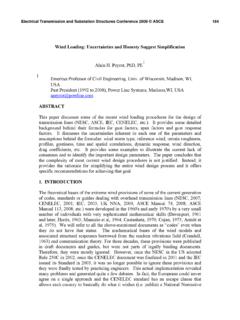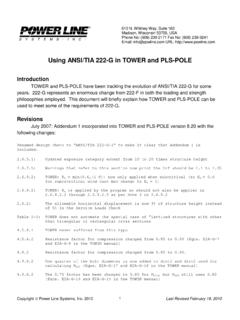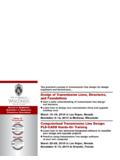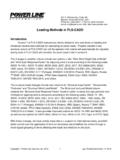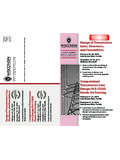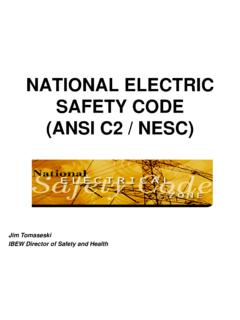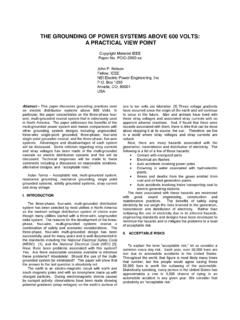Transcription of Prestressing conductors in PLS-CADD and PLS …
1 Copyright Power Line Systems, Inc. 2013 1 610 N. Whitney Way, Suite 160 Madison, WI 53705 Phone: Fax: URL: Prestressing conductors in PLS-CADD and PLS-CADD Lite Prestress is a process used by some to eliminate some or all of the permanent stretch of a conductor during construction prior to final sagging and tensioning. Modern practice is to string conductors to the initial state and then let time (creep) and weather events (load) naturally stretch the conductors . This additional stretch is accounted for on the design side so the final sags do not create any encroachments.
2 This is not only easier to construct but much safer. However, due to ACSS conductor having very little creep (some manufacturers actually specify no creep at all in the steel core of their ACSS conductor properties), tensions can remain high for many years (decades) if the overhead line doesn t experience the weather events expected under load ; this can lead to aeolian vibration problems if not accounted for (see TechNote Why is Creep ALWAYS a Factor? at ). Thus, some ACSS manufacturers are unfortunately now recommending that ACSS conductors be prestressed to simulate long term loadings as an aeolian vibration mitigation method rather than simply reducing their installed tensions and designing the overall transmisison line accordingly based on the creep tensions.
3 This paper will discuss how prestress is done in PLS-CADD and PLS-CADD LITE. For discussion purposes, a basic 1000 foot span of a typical 795 ACSR Drake is strung under 2012 National Electrical Safety Code for an arbitrarily selected location under NESC Medium (Rule 250B), 90 mph Extreme Wind (Rule 250C), and a Combined Wind and Ice of 30 mph with a 3/4" radial ice at 15 F (Rule 250D). Using the maximum tension limitations of Rule 261H1b, the maximum controlling design tension limit is 25% RTS, Final After Load. The resulting maximum tension then occurs under NESC Rule 250D of 14216 pounds horizontal tension.
4 Note also that the maximum sag at 212 F is feet. The Sag Tension report is given below; Ruling Span Sag Tension Report -------------Weather Case------------- | --Cable Load-- | Initial | Final | Final | | | | --------After Creep-------- | ---------After Load-------- | # Description | Hor. Vert Res. | Max. Hori. Max | Max. Hori. Max | Max. Hori. Max | | -----Load----- | Tens.
5 Tens. Ten C Sag | Tens. Tens. Ten C Sag | Tens. Tens. Ten C Sag | | ---(lbs/ft)--- | (lbs) (lbs) %UL (ft) (ft) | (lbs) (lbs) %UL (ft) (ft) | (lbs) (lbs) %UL (ft) (ft) | ---------------------------------------- ---------------------------------------- ---------------------------------------- ---------------------------- 1 NESC Medium District Loading (250B) 11300 11264 36 6230 10712 10674 34 5903 10664 10626 34 5877 2 NESC Extreme Wind (250C)
6 10154 10116 32 5712 9410 9368 30 5290 9371 9329 30 5268 3 NESC Concurrent Ice and Wind (250D) 14288 14216 45 4952 14285 14213 45 4951 14288 14216 45 4952 4 Extreme Ice 11813 11767 38 5620 11324 11275 36 5385 11285 11236 36 5366 5 Cold Uplift 9572 9557 30 8736 8528 8511 27 7780 8472 8454 27 7728 6 Maximum Operating 5214 5185 17 4739 4844 4812 15 4399 4844 4813 15 4400 7 NESC Tension Limit (261H1b)
7 8973 8956 28 8187 7869 7850 25 7176 7825 7805 25 7135 8 NESC Blowout 6 PSF 8269 8246 26 6725 7263 7237 23 5901 7226 7200 23 5872 9 No Wind (SWING 1) 7770 7751 25 7085 6697 6675 21 6101 6664 6641 21 6071 10 Moderate Wind (SWING 2) 8966 8945 28 7295 7948 7924 25 6462 7909 7885 25 6430 11 Moderate Wind (SWING 3) 8269 8246 26 6725 7263 7237 23 5901 7226 7200 23 5872 12 High Wind (SWING 4) 11509 11456 37 5195 10965 10909 35 4947 10931 10876 35 4932 13 GALLOPING (SWING) 11855 11808 38 5562 11375 11325 36 5334 11333 11283 36 5315 14 GALLOPING (SAG)
8 11766 11719 37 5597 11274 11225 36 5361 11229 11180 36 5340 15 -20 Deg F 10048 10033 32 9171 9080 9064 29 8285 9018 9002 29 8228 16 0 Deg F 9423 9407 30 8599 8352 8334 27 7618 8302 8284 26 7572 17 30 Deg F 8549 8531 27 7798 7438 7418 24 6781 7394 7373 23 6740 18 32 Deg F 1/2 Inch Ice 11766 11719 37 5597 11274 11225 36 5361 11229 11180 36 5340 19 60 Deg F 7770 7751 25 7085 6697 6675 21 6101 6664 6641 21 6071 20 90 Deg F 7094 7073 23 6465 6097 6072 19 5550 6069 6044 19 5525 21 120 Deg F 6514 6491 21 5934 5608 5582 18 5102 5587 5560 18 5082 22 167 Deg F
9 5772 5746 18 5253 5083 5053 16 4619 5083 5054 16 4619 23 212 Deg F 5214 5185 17 4739 4844 4812 15 4399 4844 4813 15 4400 Copyright Power Line Systems, Inc. 2013 2 (Note that due to PLS-CADD accounting for the thickness of the poles for the actual cable attachment points, the span length of the conductor in all of the examples in this paper is feet.) If a graph of Temperature versus Sag is generated (which can be done by selecting the Graph button under the Sections / Sag-Tensoin Report dialog), it can be seen that the conductor will experience additional sag, elongation, After Creep and After Load.
10 The concept of pretension is that if the conductor is pulled up to this maximum tension (and held for a specified time to be determined by the conductor manufacturer) it will then reach its maximum design load and thus its maximum design elongation. While some form of partial prestress can certainly be accomplished at a lower tension as will be dicussed later in this paper the following example of prestress will consider the ultimate solution to eliminate all long-term stress due to creep and/or weather from the conductor .
